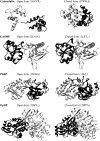The change of protein intradomain mobility on ligand binding: is it a commonly observed phenomenon?
- PMID: 16877502
- PMCID: PMC1578460
- DOI: 10.1529/biophysj.106.087866
The change of protein intradomain mobility on ligand binding: is it a commonly observed phenomenon?
Abstract
Analysis of changes in the dynamics of protein domains on ligand binding is important in several aspects: for the understanding of the hierarchical nature of protein folding and dynamics at equilibrium; for analysis of signal transduction mechanisms triggered by ligand binding, including allostery; for drug design; and for construction of biosensors reporting on the presence of target ligand in studied media. In this work we use the recently developed HCCP computational technique for the analysis of stabilities of dynamic domains in proteins, their intrinsic motions and of their changes on ligand binding. The work is based on comparative studies of 157 ligand binding proteins, for which several crystal structures (in ligand-free and ligand-bound forms) are available. We demonstrate that the domains of the proteins presented in the Protein DataBank are far more robust than it was thought before: in the majority of the studied proteins (152 out of 157), the ligand binding does not lead to significant change of domain stability. The exceptions from this rule are only four bacterial periplasmic transport proteins and calmodulin. Thus, as a rule, the pattern of correlated motions in dynamic domains, which determines their stability, is insensitive to ligand binding. This rule may be the general feature for a vast majority of proteins.
Figures






Similar articles
-
Linear response theory in dihedral angle space for protein structural change upon ligand binding.J Comput Chem. 2009 Dec;30(16):2602-8. doi: 10.1002/jcc.21269. J Comput Chem. 2009. PMID: 19373827
-
A computational investigation of allostery in the catabolite activator protein.J Am Chem Soc. 2007 Dec 19;129(50):15668-76. doi: 10.1021/ja076046a. Epub 2007 Nov 28. J Am Chem Soc. 2007. PMID: 18041838
-
Conservation and specialization in PAS domain dynamics.Protein Eng Des Sel. 2005 Mar;18(3):127-37. doi: 10.1093/protein/gzi017. Epub 2005 Apr 8. Protein Eng Des Sel. 2005. PMID: 15820977
-
Folding funnels and conformational transitions via hinge-bending motions.Cell Biochem Biophys. 1999;31(2):141-64. doi: 10.1007/BF02738169. Cell Biochem Biophys. 1999. PMID: 10593256 Review.
-
Modulating Mobility: a Paradigm for Protein Engineering?Appl Biochem Biotechnol. 2017 Jan;181(1):83-90. doi: 10.1007/s12010-016-2200-y. Epub 2016 Jul 23. Appl Biochem Biotechnol. 2017. PMID: 27449223 Review.
Cited by
-
Osmolyte-Like Stabilizing Effects of Low GdnHCl Concentrations on d-Glucose/d-Galactose-Binding Protein.Int J Mol Sci. 2017 Sep 19;18(9):2008. doi: 10.3390/ijms18092008. Int J Mol Sci. 2017. PMID: 28925982 Free PMC article.
-
Structural Perturbations due to Mutation (H1047R) in Phosphoinositide-3-kinase (PI3Kα) and Its Involvement in Oncogenesis: An in Silico Insight.ACS Omega. 2019 Sep 20;4(14):15815-15823. doi: 10.1021/acsomega.9b01439. eCollection 2019 Oct 1. ACS Omega. 2019. PMID: 31592171 Free PMC article.
-
Conformational behavior of coat protein in plants and association with coat protein-mediated resistance against TMV.Braz J Microbiol. 2020 Sep;51(3):893-908. doi: 10.1007/s42770-020-00225-0. Epub 2020 Jan 13. Braz J Microbiol. 2020. PMID: 31933177 Free PMC article.
-
Spectral characteristics of the mutant form GGBP/H152C of D-glucose/D-galactose-binding protein labeled with fluorescent dye BADAN: influence of external factors.PeerJ. 2014 Mar 18;2:e275. doi: 10.7717/peerj.275. eCollection 2014. PeerJ. 2014. PMID: 24711960 Free PMC article.
-
Structural insights into the RNA interaction with Yam bean Mosaic virus (coat protein) from Pachyrhizus erosus using bioinformatics approach.PLoS One. 2022 Jul 22;17(7):e0270534. doi: 10.1371/journal.pone.0270534. eCollection 2022. PLoS One. 2022. PMID: 35867657 Free PMC article.
References
-
- Wriggers, W., and K. Schulten. 1997. Protein domain movements: detection of rigid domains and visualization of hinges in comparisons of atomic coordinates. Proteins. 29:1–14. - PubMed
-
- Hayward, S., and H. J. Berendsen. 1998. Systematic analysis of domain motions in proteins from conformational change: new results on citrate synthase and T4 lysozyme. Proteins. 30:144–154. - PubMed
-
- Hinsen, K. 1998. Analysis of domain motions by approximate normal mode calculations. Proteins. 33:417–429. - PubMed
-
- Hinsen, K., A. Thomas, and M. J. Field. 1999. Analysis of domain motions in large proteins. Proteins. 34:369–382. - PubMed
-
- Tama, F., F. X. Gadea, O. Marques, and Y. H. Sanejouand. 2000. Building-block approach for determining low-frequency normal modes of macromolecules. Proteins. 41:1–7. - PubMed
MeSH terms
Substances
LinkOut - more resources
Full Text Sources

